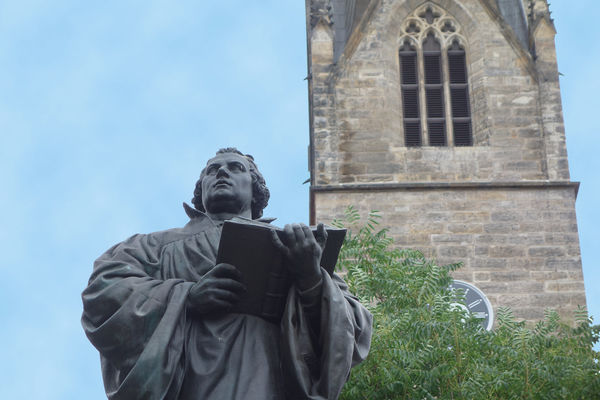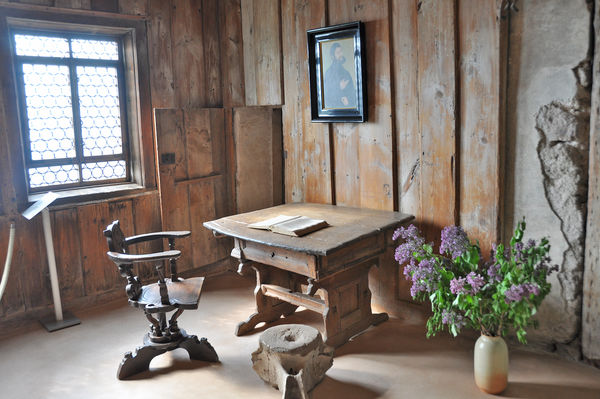Visiting Germany’s Lutherland
By Rick Steves

Martin Luther — a pious monk and fiery orator who became the "Great Reformer" — came from a humble, pastoral corner of Germany's heartland. It's a land of half-timbered villages, rolling hills, and fanciful castles — and where Luther's bold attempts to reform the Catholic Church launched the Protestant Reformation. October 2017 marked the 500th anniversary of this event, which, along with the Renaissance and as part of the rise of humanism, contributed greatly to the birth of our modern world.
On Oct. 31, 1517, Luther challenged Roman Catholic doctrine by posting his 95 Theses (discussion topics) on a church door. This started a chain of events that would split Western Christian faith, plunge Europe into a century of warfare, cause empires to rise and fall, and inspire new schools of art and thought. In eastern Germany, near Leipzig, three "Lutherland" destinations — Erfurt, Wartburg Castle, and Wittenberg — are the top spots for a Luther pilgrimage, newly spruced up with loving attention.
OK, I'll admit it — I'm a Lutheran. For me, coming to Lutherland is a bit like a Catholic going to Rome. But anyone who appreciates history will find the sights here interesting.
Start in Erfurt, a charming many-steepled medieval town that Luther himself would still recognize. Young Luther enrolled at the university here, and, after a lighting-storm epiphany in 1505, became a monk. Today, visitors can tour the Augustinian Monastery and Church, including the austere cell where Luther spent his formative years, and the church where he struggled with theological demons.
Just west of Erfurt is another important Luther landmark: Wartburg Castle, perched over the town of Eisenach. When Luther spoke out against Church corruption, he made enemies of the pope and emperor. Luther was declared a heretic — "outside the protection of the law" — and could be captured and killed by anyone. While traveling nearby, he was "kidnapped" and dropped out of sight.
Days later, a man named Junker Jörg ("Squire George") appeared at Wartburg Castle — a disguised Martin Luther, who had been taken by agents of his benefactor, Prince Frederick the Wise. Safely hidden behind Wartburg's stout walls, Luther spent nearly a year making his next stand against the Vatican, diligently translating the New Testament from original Greek sources (previous German Bible translations were done from Latin translations, so were not as accurate). Luther's text helped shape standard written German — making Wartburg, in a sense, the birthplace of the modern German language.
At Wartburg Castle, stop at the museum. A few opulent rooms were lavishly redecorated during a surge of German pride in the late 1880s, and paintings show how it looked before reconstruction. A highlight here is the humble Luther Room, where Luther hunkered down to translate the New Testament.
Our last stop is little Wittenberg, Luther's adopted hometown, which still feels unassuming despite its status as the epicenter of one of Western civilization's biggest shakeups. One of its top sights is the Church of All Saints (a.k.a. Castle Church), with Luther's modest tombstone inside, and where Luther posted his 95 Theses. The act wasn't quite as defiant as it sounds, since the church door already served as sort of a community bulletin board — but the strong arguments Luther made about Church corruption were revolutionary.
Nearby is the Town Church of St. Mary, where Luther was married, where his children were baptized, and where he preached over 2,000 times. This is where what many consider to be the first-ever Protestant church service took place, on Christmas Day in 1521.
A few blocks further you'll find Luther House, his former home. It's now an excellent museum displaying original paintings, manuscripts, and other Luther-era items — including his pulpit, famous portraits of Luther and the other reformers by Lucas Cranach, and Luther's original German translations of the New Testament as well as the complete Bible.
After he broke with Rome, the 42-year-old Martin Luther married 26-year-old Katherine von Bora, a former nun. It was here that she gave birth to six children (the couple also adopted four orphans). It was a happy marriage. Luther wrote, "Marriage is a better school for the character than any monastery, for it's here that your sharp corners are rubbed off."
Luther House's centerpiece is the "Lutherstube" — the room with benches, a stove, and the table where Luther engaged in spirited conversations with his colleagues. If you visit, you may notice the names scratched into this room's ceiling, left behind by visiting VIPs (on the door, protected by glass, is the John Hancock of Russian Czar Peter the Great).
After Luther's death in 1546, until the dawn of the 20th century, the Reformation helped open the way for fundamental changes in Western society. With a less controlling role of the Church in everyday life, secular forces were free to flourish. Lutherland's sights are physical reminders of courageous accomplishments of the Reformation — and the enduring example Martin Luther set for those who dare to speak truth to power.

